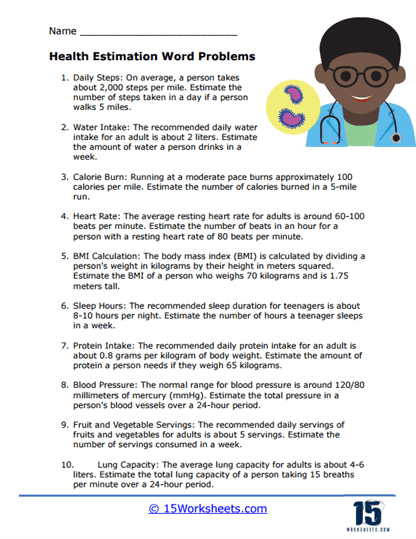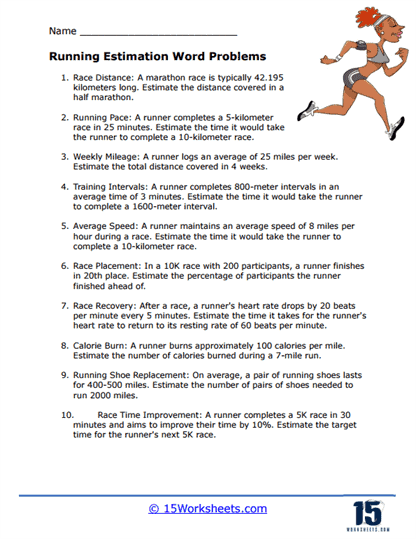Estimation Word Problems Worksheets
About These 15 Worksheets
Estimation word problem worksheets are educational tools designed to help students develop their ability to make approximate calculations and estimations in real-life situations. These worksheets present scenarios where students are asked to provide an estimate of a quantity or result rather than calculating an exact answer. Estimation is an essential skill in mathematics and everyday life because it allows individuals to quickly assess the reasonableness of their answers and make informed decisions without the need for precise calculations.
1. Everyday Data & Social Trends (Texting • Social Media Estimation)
Kids start by diving into the digital world in “Texting” and “Social Media Estimation.” These worksheets ask them to estimate how many texts someone sends in a day, or how many likes and shares a post might rack up. It’s a clever way to blend math with students’ real lives-especially when they’re snickering about mom using ten emoji in a single sentence or junior’s Instagram post getting “zero likes…again.” This builds number‑sense in a context they actually care about (or secretly judge).
2. Numbers in Nature & Science (Plant Word Problems • Animals Estimation • The Sun • Ocean Estimation)
Next, things get scientifically snazzy. “Plant Word Problems” has students estimating seed counts or tree heights-perfectly priming the budding botanists. “Animals Estimation” is a safari of big guesses: from how many ants in a colony to kangaroos in a leap‑off. “The Sun” brings cosmic estimation-calculating sunlight hours or the Sun’s size in relatable terms. And “Ocean Estimation” plunges them into watery realms-how many fish in a school or bottles to fill a bathtub‑sized wave. These exercises hone estimation skills across vastly different scales, from microscopic to infinite.
3. Lifestyle, Health, and Sustainability (Health Word Problems • Cooking Estimation • Electric Cars)
Here the worksheets get practical-and a bit eco‑friendly. “Health Word Problems” has learners guessing daily calorie burn or glass‑of‑water intake. “Cooking Estimation” asks them to guesstimate ingredient quantities-like cups of flour or spoons of sugar needed to bake a cake (and, accidentally, how fast mom grabs the mixer). “Electric Cars” encourages extrapolation: how far can a charge go, or how many cars escape exhaust if our fleet goes electric? These questions spark both estimation skills and societal awareness.
4. Adventure & Sport (Sports Estimation • Camping • Running • Dog Word Problems)
Time to get out the tent and hit the track-or walk the dog. “Sports Estimation” has kids predicting scores, distances run, or how many soccer balls fit in a bus. “Camping” tests survival skills: food rationing, tent‑packing estimates, or water‑for‑marshmallows guesses. “Running” drills into distances, speed, and end‑of‑race predictions. “Dog Word Problems” is a warm‑fuzzy tribute-how many bones does a dog bury in a week? How far does it walk on a whim? These worksheets engage spatial thinking and real‑world planning-with a wagging tail cameo.
5. Academic Level & Grade Review (Grade 6 • Grade 7 • Grade 8)
Finally, the curriculum catch‑alls: “Grade 6,” “Grade 7,” and “Grade 8 Estimation.” These tiered worksheets provide age‑appropriate rigour, reviewing proportions, decimals, and concepts like rounding to the nearest ten or hundred. They’re the final boss levels-ensuring foundational estimation skills are rock‑solid before students level up academically. (Plus, they come with fewer jokes-because by middle school, humor’s a rare spice.)
What Are Estimation Word Problems?
Estimation word problems are mathematical problems that require you to make approximate calculations rather than precise calculations. In these problems, you are given a scenario or a real-life situation, and you need to estimate or make an educated guess about the answer using reasonable and logical approximations.
Estimation word problems are often encountered in everyday life when you need to quickly assess a situation or make rough calculations without the need for exact values. They help develop your ability to think critically, make informed judgments, and provide a reasonable estimate based on the given information.
These problems typically involve quantities such as distances, measurements, weights, or quantities of items. They may ask you to estimate the total cost of a purchase, the time it takes to complete a task, the number of people attending an event, or the amount of material needed for a project. The goal is to provide an approximate answer that is within a reasonable range, even if it is not exact.
Estimation word problems are particularly useful when precise calculations are not practical or necessary. They allow you to quickly assess a situation and make decisions based on a reasonable approximation. Estimation skills are valuable in various fields, such as engineering, finance, construction, and everyday problem-solving.
When solving estimation word problems, it is important to consider the given information, use your knowledge and experience to make reasonable assumptions, and perform calculations that provide a ballpark estimate. It’s often helpful to round numbers, use mental math techniques, and rely on your intuition to arrive at an approximate answer.
Example Estimation Word Problems
Problem 1 (Easy): Estimate the total cost of buying 9 books, each priced at $15.
Solution: To estimate the total cost, you can round the price of each book to the nearest ten dollars, which is $10 in this case, and then multiply it by the number of books:
Estimated cost per book = $10
Total estimated cost = Estimated cost per book x Number of books
Total estimated cost = $10 x 9
Total estimated cost = $90
So, the estimated total cost of buying 9 books is $90.
Problem 2 (Intermediate): Estimate the result of multiplying 348 by 72.
Solution: To estimate the product of 348 and 72, you can round both numbers to the nearest hundred and then multiply them:
Rounded value of 348 = 300
Rounded value of 72 = 70
Now, multiply the rounded values:
Estimated product = Rounded value of 348 * Rounded value of 72
Estimated product = 300 x 70
Estimated product = 21,000
So, the estimated result of multiplying 348 by 72 is 21,000.
These estimations provide quick approximations to help assess reasonableness or make ballpark calculations without the need for precise multiplication.
How to Estimate of a Value of a Number
Identify the context – Understand the problem or scenario in which the number is presented. This will help you determine the appropriate approach for estimation.
Round numbers – Round the given numbers to simpler, more manageable values. For example, if you have a number like 367, you might round it to 400 or 300 to make calculations easier.
Use benchmarks – Compare the number you want to estimate to familiar benchmarks or reference points. These benchmarks could be numbers you know well or commonly encountered values. For instance, if you’re estimating the weight of an object, you can compare it to the weight of familiar objects like a bag of flour or a liter of water.
Break it down – If the number you’re estimating is large or complex, try breaking it down into smaller, more manageable parts. Estimate each part separately and then combine the estimates to arrive at an approximate total. This can be useful when estimating costs, quantities, or time.
Make assumptions – When necessary, make reasonable assumptions based on your knowledge or experience. These assumptions can help you simplify the problem and arrive at an estimate. Just ensure that your assumptions are logical and appropriate for the context.
Use mental math – Employ mental math techniques such as rounding, estimation, or approximation. For instance, if you need to calculate the product of two numbers, you can round them to the nearest tens or hundreds, perform the multiplication mentally, and adjust the final result accordingly.
Adjust and refine – Once you’ve made your initial estimate, consider whether it seems reasonable or if any adjustments are necessary based on additional information or insights. Refine your estimate as needed until you arrive at an approximation that is within a reasonable range.
What Careers Require This Skill?
Construction – Construction professionals, such as architects, engineers, project managers, and contractors, need to estimate quantities of materials, project costs, timelines, and labor requirements. Estimation is crucial for budgeting, planning, and executing construction projects successfully.
Finance and Investment – Financial analysts, investment managers, and stock traders often need to estimate the value of assets, market trends, and investment returns. Estimation plays a vital role in assessing risks, making investment decisions, and forecasting financial outcomes.
Business and Entrepreneurship – Entrepreneurs, business owners, and managers frequently rely on estimation to assess market demand, sales projections, budgeting, pricing strategies, and resource allocation. Estimation helps in making informed decisions and managing business operations effectively.
Logistics and Supply Chain Management – Professionals working in logistics and supply chain management need to estimate shipping costs, transportation times, inventory levels, and demand forecasting. Accurate estimation ensures efficient supply chain operations and timely delivery of goods and services.
Sales and Marketing – Sales representatives and marketers often estimate market size, customer acquisition rates, revenue potential, and return on investment (ROI) for marketing campaigns. Estimation helps in setting sales targets, planning promotional activities, and evaluating marketing effectiveness.
Project Management – Project managers across various industries, including IT, engineering, and consulting, rely on estimation to define project scope, allocate resources, set timelines, and determine project budgets. Estimation is essential for managing project constraints and ensuring successful project completion.
Data Analysis and Statistics – Professionals in data analysis, statistics, and research fields use estimation techniques to analyze data, draw conclusions, and make predictions. Estimation plays a critical role in statistical sampling, hypothesis testing, and population parameter estimation.
Risk Management – Risk managers and insurance professionals estimate the likelihood and potential impact of various risks, such as natural disasters, accidents, or financial losses. Estimation helps in determining appropriate risk mitigation strategies and insurance coverage.
Real Estate – Real estate agents, appraisers, and property developers regularly estimate property values, rental incomes, and market trends. Estimation is crucial for pricing properties, negotiating deals, and making informed investment decisions.
Manufacturing and Production – Professionals in manufacturing and production industries estimate production costs, material requirements, production timelines, and capacity planning. Estimation is essential for optimizing production processes and ensuring cost-effective operations.
















